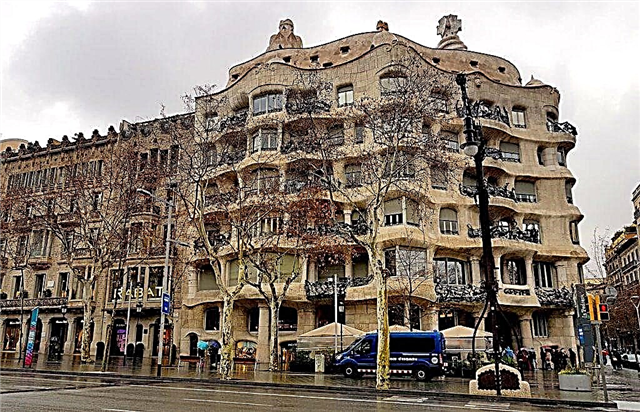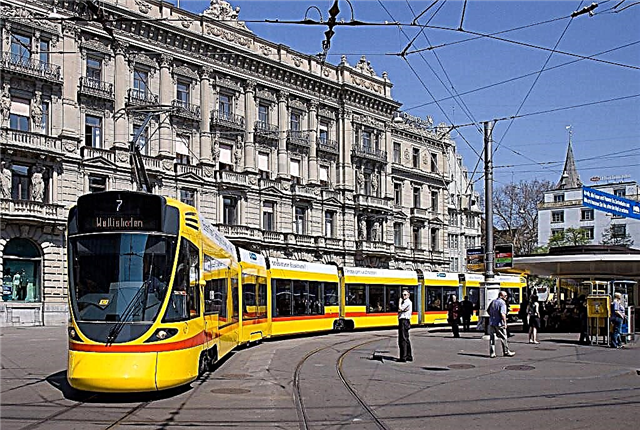Address: Estonia, Tallinn, st. Barking
Foundation date: XIII century
Height: 124 m
Coordinates: 59 ° 26'28.8 "N 24 ° 44'51.1" E
Content:
Short description
Citizens and tourists arriving in Tallinn by sea, tens of kilometers from the coast, can see the Church of St. Olaf (or Oleviste).

In 1549 - 1625, the Oleviste temple bore the title of the tallest building in medieval Europe, and to this day its spire, soaring 124 meters high, makes a majestic impression. At the turn of the 16th century, the church spire, reaching a height of 159 meters, not only served as a reliable reference point for ships, but was also a good target for lightning. 8 times the church was struck by lightning, three times it burned during a thunderstorm.
According to legend, the blaze of fire from the fire could be seen even from the shores of Finland. Today, St. Olaf's Church is included in the TOP-20 of the tallest churches in the world and is the second tallest structure in Tallinn after the Tallinn TV Tower.... To pay due respect to the old church, the authorities of Tallinn adopted a decree prohibiting the construction of skyscrapers in the city center above the Oleviste spire.

Towers of the fortress wall against the background of the Church of St. Olaf
Legend about the construction of the Church of Oleviste
Legend has it that many centuries ago, the people of Tallinn decided to erect in their city a large church with such a high spire that foreign merchants sailing on ships could see it. Among the masters, there was an unfamiliar architect who was willing to take on such a difficult task, but for his work he asked for 10 barrels of gold. For the city authorities, this price was too high, and then the master put forward an unusual condition - if Tallinn residents recognize his name, then he will not take a penny for his work, otherwise the fee remains unchanged. When the construction of the temple was nearing completion, the townspeople sent a spy to the architect's wife. Waiting until nightfall, the scout crept up to the window and overheard the words of a lullaby humming to her child: “Sleep, my baby, go to sleep. Tomorrow Daddy Olev will return home with ten barrels full of gold. " When the mysterious master was already placing the cross on the top of the spire, the townspeople called out to him: “Hey, Olev! And your cross is tilted! " The frustrated master released the cross from his hands, the scaffolding sagged under his feet, and Olev flew down, hitting the ground. At the same moment his body turned to stone, and a frog jumped out of his mouth, and a snake crawled out.

View of the church from Oleviste street
The townspeople believe that Olev fell victim to an evil spirit, because without the participation of a demon it is impossible to build such a grandiose structure. The church was consecrated in honor of the canonized Norwegian king Olaf II, who established Christianity in Norway, and the people call it the Oleviste temple - after the master Olev.
History of the Church of Oleviste
Historians believe that the Church of St. Olaf already in the XII century stood at its present place - where in the Middle Ages there was a trading yard of Scandinavian merchants. In written evidence from 1267, the Church of Oleviste is mentioned as a functioning temple under the tutelage of the Cistercian convent of St. Michael... In the 1420s, the Oleviste church underwent rebuilding: the longitudinal baptismal church was turned into a basilica, new vaults and choirs were erected. In 1524, during the reformation movement against the abuses of the Catholic Church, the Catholic clergy were expelled from the churches of Tallinn. On the night of September 14, 1524, a reformist crowd plundered the interior of the church of St. Olaf, but the outside of the temple was not damaged.

View of the church from Lai street
Since then, the Oleviste Church has become Lutheran, and in 1950, under the arches of this historic building, the seven religious communities of Estonia were united, creating a single Estonian brotherhood. The Livonian chronicler Balthazar Russov in the chronicles of the life of Tallinn reports another curious event related to the history of the Church of Oleviste. In 1547, a troupe of traveling artists stopped passing through Tallinn. Pulling a rope between the fortress wall and the tower of the church of St. Olaf, the acrobats decided to amuse the "most respectable audience." One artist performed dizzying tricks on the tightrope, while the other walked down the tightrope.
Attractions of the Church of Oleviste
The main decoration of the church of St. Olaf's are Gothic stellated vaults, in which the intersection of framed arches creates a complex "stellar" geometric pattern... The old sculptural relief of St. Olaf, located behind the altar, and the chapel of the Virgin Mary, annexed to the east side of the church. On the outer wall of the chapel of Mary, a symbolic slab (cenotaph) is installed in memory of the initiator of the construction of the chapel, Hans Pavels (1513).

Cathedral interiors
On the cenotaph in the stone there are cutouts of the image of eight scenes of the suffering of I. Christ and the biblical wisdom in the old German language is carved: “What I gave will remain with me. What I own is lost to me. Let no one think too highly of himself, for human life is elusive, like smoke. " At the end of the tour of the Oleviste Church, you can climb the spiral staircase to the observation deck and enjoy the bird's-eye views of Tallinn.











